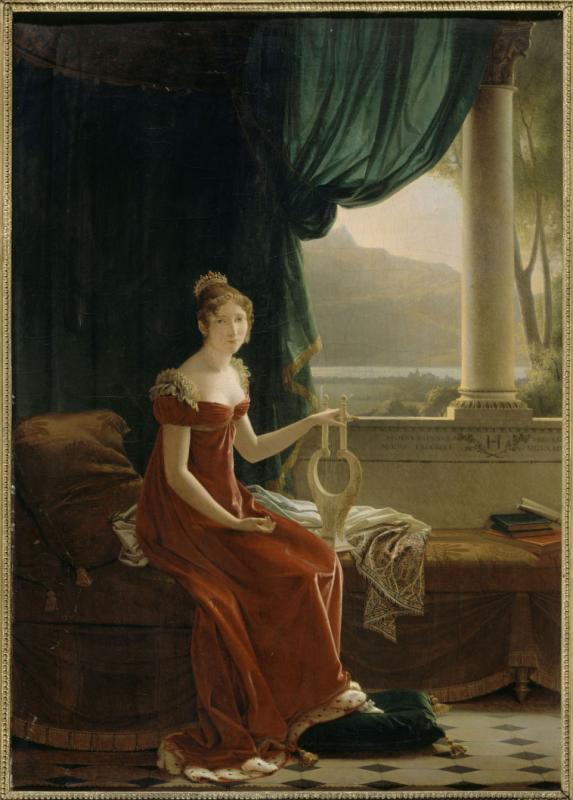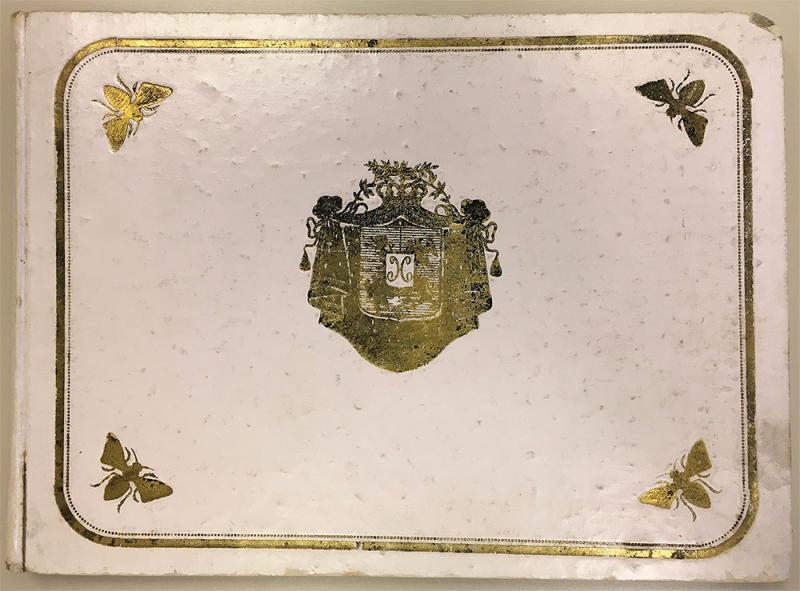Being a cataloger at an institution like the Morgan means being surprised on an almost daily basis. You never know what will come across your desk. In early 2023, I took on the task of completing the cataloging of a large collection of nineteenth and twentieth century French music scores and sheet music. The collection of over 500 items was purchased by the Morgan in 2017, and its cataloging had been interrupted by the recent pandemic.
The front cover and two chromolithographed plates, Album artistique de la Reine Hortense. Paris : Heugel & Cie., editeurs, 2bis rue Vivienne, [between 1853 and 1860]. Purchased on the Mary Flagler Cary Fund, 2017. The Morgan Library & Museum, PMC 2782.
French music consumers liked their sheet music heavily illustrated, and consequently many French scores are valued by collectors and institutions more for their artwork than their music. The majority of the collection is sheet music for individual songs by popular chanson composers, illustrated with a single image—usually a lithograph—that vaguely refers to the lyrics of the song. There are also a fair number of volumes containing multiple scores and multiple illustrations, though most of these are also by composers familiar to us today.
But one volume is a bit less familiar. Bound in boards covered in coated white paper and stamped with a gold coat of arms surrounded by four golden bees, it features eight vibrantly colored plates, the scores and lyrics for twelve songs, a biographical sketch, transcriptions of personal letters, and seven monochrome plates of historical and landscape scenes. It is titled Album artistique de la Reine Hortense, by one Auguste Louis Charles, Comte de La Garde-Chambonas, and published in Paris by Heugel et Cie. It is undated. But who was Queen Hortense?
Hortense Eugénie Cécile de Beauharnais was born in 1783, the second child of Alexandre, Vicomte de Beauharnais and his wife, the former Marie-Josephe-Rose Tascher de la Pagerie, known as Rose. Her parents separated when she was five, and she was sent to live in her mother’s native Martinique for the next five years. Her father was executed during the French Revolution. After she returned to France, she was sent to a boarding school run by a former lady-in-waiting to Marie Antoinette, where she began her lifelong love affair with art and music; she spent those years drawing, composing and taking instruction in singing and piano. Not long after, her mother Rose—now known as Josephine—married the Revolutionary General Napoleon Bonaparte, and Hortense’s life would never be the same.

A young Queen Hortense portrayed, as she often was, with a musical instrument. Fleury Richard. La Reine Hortense, 1815. CC-BY 2.0 license.

Hortense and her eldest son, who died in 1807 at the age of four. François Gérard. Hortense de Beauharnais with her son Napoleon Charles Bonaparte (detail), between 1806–1807. CC-BY 2.0 license.
At nineteen, Hortense was “persuaded” to marry her stepfather’s brother Louis Bonaparte, five years her senior and subject to intermittent bouts of mental illness. It was not a happy marriage. When Napoleon named her husband King of Holland she did her best to remain in Paris, to no avail. Holland, however, proved to be more pleasant than she had anticipated. She was popular with the Dutch people, and she learned to paint in watercolor, traveling the countryside for subjects while avoiding Louis as much as possible. After her first child, Napoleon-Louis-Charles, died of croup at the age of four, she was allowed to return to France on the assumption that it would offer a healthier environment for her remaining son, Napoleon-Louis—who would eventually become King Louis II of Holland.
She lived at Malmaison, surrounded by her mother’s beloved roses. Around this time Hortense set Alexandre de Laborde’s poem “Le beau Dunois” to music as “Partant pour la Syrie,” which would become a popular anthem during the later years of her stepfather’s reign and during her son Charles-Louis-Napoleon’s reign as Napoleon III. Camille Saint-Saens would later quote it in his “Carnival of the Animals.” Another song, “Le bon chevalier” from 1807, formed the basis for Schubert’s 1818 composition “Variationen über ein französisches Leid für das Piano-Forte auf vier Händen.” Ultimately, her body of musical work would consist of 124 “romances,” songs with heroic, sentimental overtones.
After a brief reconciliation with her husband in Toulouse a third son, Charles-Louis Napoleon, was born in Paris in 1808. Napoleon Bonaparte annulled his marriage to Hortense’s mother in 1810 and Hortense was forced to return to Holland, but neither her husband nor the Dutch welcomed her back, and soon she made the break permanent, moving to back to France and beginning a relationship with Charles Joseph, Comte de Flahaut. She gave birth to their son Charles August Louis Joseph in 1811 in secret in Switzerland (he would eventually be named Duc de Morny when his half-brother took the throne in France), and would return to Switzerland for good when she was banished from France at the end of Napoleon’s reign as Emperor. No longer Queen, she was granted the title Duchess of Saint-Leu.

Chateau Arenenberg, Hortense’s home in Switzerland. Emanuel Labhardt. View of the castle of Arenenberg, canton of Thurgau, Switzerland, circa 1840. CC-BY 2.0 license.

An older Hortense at Arenenberg, seated at a stylized pyramid piano. Félix Cottrau. Portrait der Königin Hortense, 1832 or 1834. CC-BY 2.0 license.
Continuing political intrigues made it impossible for Hortense to ever return permanently to France. After a period of travel she purchased a chateau in Switzerland, and renovated and decorated it to evoke Malmaison. There she lived until her death from cancer in 1837 at the age of 54. In Switzerland Hortense wrote her memoirs, composed songs, drew, painted, and held salons for prominent French artists, musicians, and writers, turning the house and its gardens into “a corner of France.”
The provenance of the Album artistique is harder to tease out. The volume held by the Morgan seems to be the original edition. (A larger, more elaborate edition, bound in bright green velvet or moire silk and with the added title “Livre d’art de la Reine Hortense” was published around 1860.) It was probably issued in 1853, a year into the reign of her son Napoleon III as Emperor of France—though the dedication page, offering “Hommage a sa Majesté Napoléon III,” has been removed.
Though his primary claim to fame was as a travel writer, the Comte de La Garde-Chambonas was also the author of Memoires sur Madame la duchesse de St. Leu, ex-reine de Hollande (1832), and therefore familiar with Hortense and her life and work. Interestingly, La Garde chose not to include “Partant pour la Syrie” or “Le bon chevalier” in the Album artistique. He did, however, include the touchingly titled “Lay de l’exil.” Of the seven monochrome plates in the book, one is a portrait of Hortense as muse, by Leon Noel; the other six are lithographed versions of her artwork.
A particularly poignant image shows a young woman in a beautifully landscaped garden with a distant lake, carving a message into a tree. A guitar sits on a bench behind her, along with her discarded cloak. The inscription in the bark reads “Moins connue, moins troublée”—Less known, less troubled.
Today, Hortense’s visual and musical works are acknowledged by entries in the Getty Union List of Artist Names, the Benezit Dictionary of Artists, the Allgemeines Künstlerlexikon, and the Grove Dictionary of Music. Some are not without a touch of condescension, as in the Grove Dictionary’s description:
Most of the texts were written by Count Laborde, and the queen’s melody was then developed by a professional such as Dalvimare, harp master to Empress Joséphine, the composer Plantade, or the singing master J.F.N. Carbonel. This unpretentious music exemplifies the taste of contemporary society for light, pastoral, sentimental subjects. Although simple and naive, they are expressive and elegantly written, thanks to the skill of her musical colleagues. [emphasis added]

Anne-Louis Girodet-Trioson. Portret van Hortense de Beauharnais, koningin van Holland, between 1805–1809. CC-BY 2.0 license.
I will not go into the long history of the diminishment of women’s accomplishments here, but I cannot help but be a little outraged on Hortense’s behalf. One wonders if popular male songwriters of the day would be so casually dismissed when their work had inspired composers like Schubert and Saint-Saens. She may have lived most of her life in comfort and relative safety (as a fair number of male composers of the day also did), but neither was she a stranger to grief and pain. Much of her life was dictated by others, and out of her control. That she managed to retain a small degree of autonomy, and find refuge in her own creativity, I find admirable and inspiring.
Bibliography
- Baldassarre, Antonio. “Music, Painting, and Domestic Life: Hortense de Beauharnais in Arenenberg.” Music in Art, Vol 23, No. 1 / 2, Music Iconography: Transmission and Transformation of Symbolic Images (Spring/Fall 1998), pp. 49–61.
- Wikipedia. “Hortense de Beauharnais.” Accessed November 10, 2023.
- Wikipedia. “Josephine de Beauharnais,” Accessed November 10, 2023.
- Wikipedia. “Louis Bonaparte,” Accessed November 10, 2023.
- Wikipedia. “Napoleon III.” Accessed November 10, 2023.
- Grove Dictionary of Music. “Hortense (Eugenie de Beauharnais).” Accessed November 10, 2023.
- La Garde-Chambonas, August Louis Charles. Mémoires sur Madame la duchesse de St.-Leu, ex-reine de Hollande. London: Colburn & Bentley, 1832.
- Regency Town House. “A Visit to Brighton by Auguste Louis Charles, Comte de La Garde.” Accessed November 10, 2023.
Lenge Hong
Special Collections Cataloger
The Morgan Library & Museum




